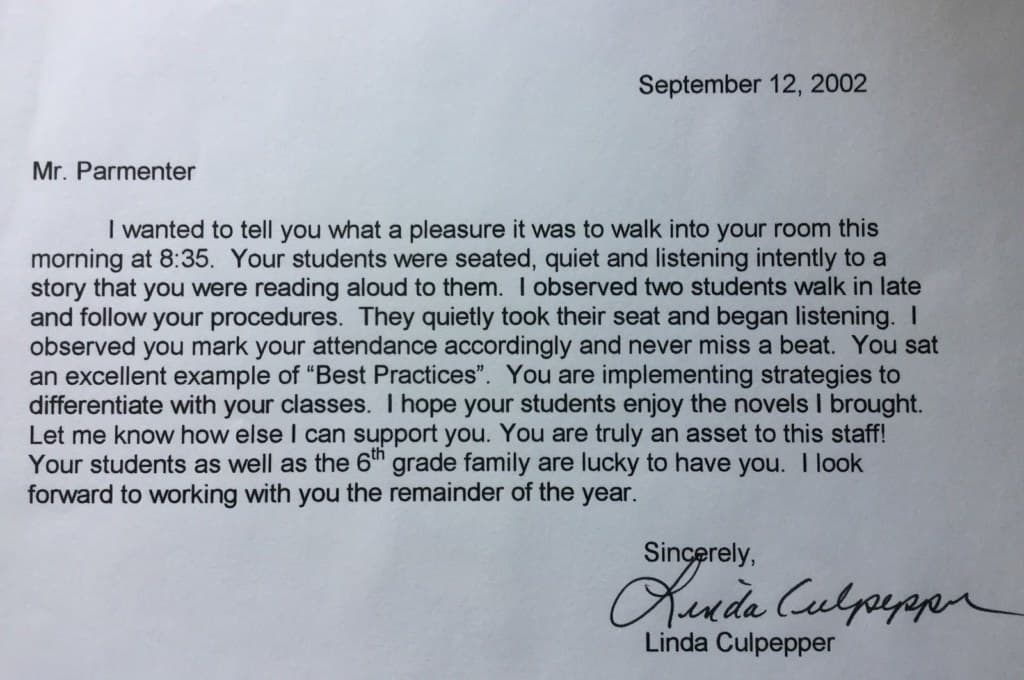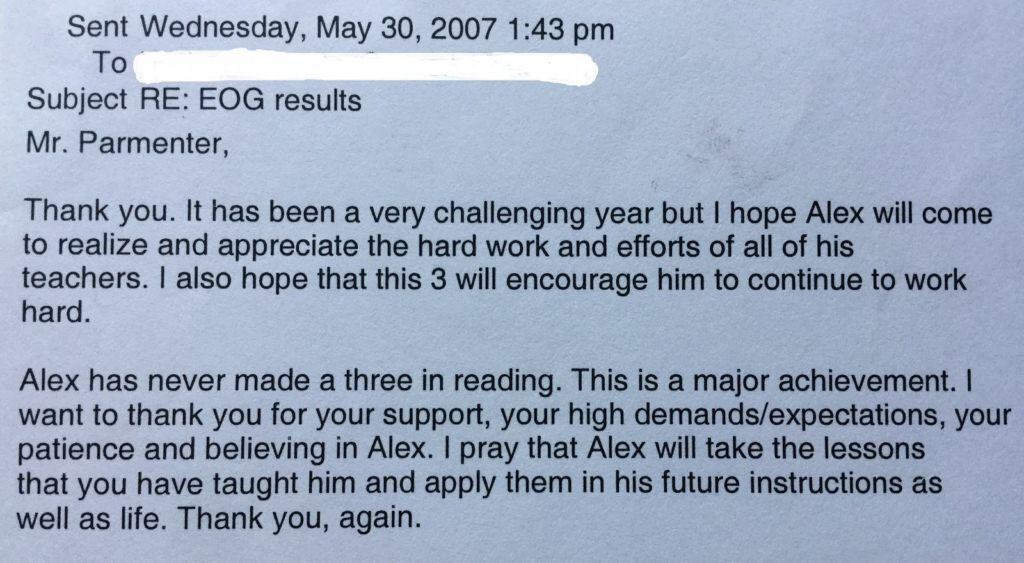It was 2009, and the world was reeling in the wake of a global financial meltdown caused by failed business practices that preyed on working class people. Against that backdrop I was called to the principal’s office one afternoon. Ms. Olshausen explained to me that a company called SAS had developed a proprietary model which they claimed could precisely measure what value an individual teacher was adding to each student’s achievement.
It was part of the broader push I had been hearing about applying a business model in education in order to improve results. It struck me as an odd time to be holding up the business world as the gold standard for achieving desired outcomes, but I was intrigued by the possibility of learning more about my impact as an educator.
Ms. Olshausen went on to tell me that the analysis of my test data over the past few years indicated that I was above average in the ‘value’ I was adding to my students’ growth as defined on their end-of-year reading test. I was so proud I went home and put the paper in a shoebox reserved for especially motivational documents. Finally, an answer to the question that had been nagging me inwardly for years: I was a good teacher! I really was making a difference, and I had the data to prove it!

In the years that followed, EVAAS was rolled out on a larger scale across the district and state, and similar data measuring teacher effectiveness was made available to more teachers. I was dismayed to see that, while some years I apparently had made a difference, there were other years when I did not make much of a difference at all. Some years I even made a negative difference.
As teachers began to talk with each other about their own value added measures, I learned that my friend Laura, a teacher who inspired me through her constant innovation, her ability to build positive relationships with students, and her use of data to tailor instruction to individual needs, had received relatively low EVAAS results — the same year 100 percent of her Algebra students had passed their end-of-year exam.
The results for many other colleagues, when compared with anecdotal information and school-level data which we knew to be accurate, were equally confusing, and sometimes downright demoralizing. Measures billed by the SAS corporation as enabling teachers to “make more informed, data-driven decisions that will positively influence student outcomes” instead left them with no idea how to do so. Yet despite the obvious problems with the data, there were rumblings in the district about moving toward a system where teacher salaries were determined by EVAAS effectiveness ratings — a really scary proposition in the midst of the worst recession in decades.

I began to realize that the notion that anyone could accurately measure exactly what value I was adding to each of my students’ learning was false, as was the idea that I could use this EVAAS data for much more than a ticket to an emotional roller coaster ride.
Over the past few years, more and more research has shown that value added ratings are highly unstable and are unable to account for the many factors that influence our students and their progress. Lawsuits have sprung up from Texas to Tennessee, charging, among other things, that use of this data to evaluate teachers and make staffing decisions violates teachers’ due process rights, since SAS refuses to reveal the algorithms it uses to calculate scores.
Despite the growing questions about its efficacy, taxpayers of North Carolina continue to spend more than $3.5 million a year for EVAAS, and SAS founder and CEO James Goodnight is the richest man in the state, worth nearly $10 billion. The view that, like a good business, we will somehow be able to determine the precise value of each member of our ‘corporation’ and reward them accordingly, persists — as does the notion that applying business strategies to our schools will help us achieve desired outcomes.
In 2016, state legislators set aside funds to reward third grade teachers whose students showed significant growth on standardized tests and high school teachers whose students passed Advanced Placement or International Baccalaureate exams. Under this system of merit pay, which will continue through 2018, third grade teachers compete against each other to get into the top 25 percent for reading test growth. But if the General Assembly’s goal was to increase teachers’ effectiveness by motivating them to dig deep for the ideas they’d been holding back, the plan seems to have backfired.
I spoke with teachers from across the state and found there was zero impact from the bonus scheme in some schools and negative impacts in others. Some teachers weren’t even aware that there had been a bonus available for them to work toward, indicating a crucial breakdown in communication if the goal was to create a powerful incentive. On the other end of the scale, some teachers had been very aware of the bonus and had jockeyed for position to land students who were primed for the highest amount of growth. When these sizable bonuses were awarded — $9,483 to some teachers in Mecklenburg Count — resentment flared among teachers who had previously collaborated and shared best practices to the benefit all students. It takes a village to educate a child, and the General Assembly’s plan ignored key players who contribute to student growth — everyone from school counselors to EC teachers to literacy specialists.
Research on the impact of financial incentives in education shows that, not only do they fail to increase student achievement, in some cases they even decrease it. The competitive nature of such incentives isolates teachers and harms relationships so critical to maintaining a positive school culture.
Ironically enough, while we have been busy trying to emulate business practices that don’t improve our outcomes in education, the business world has begun to recognize the importance of collaboration over competition. Sparta CEO James Pember recently said this about how to increase sales:
Contrary to popular belief, the best sales teams aren’t a pack of “lone wolves”. Yes, each team probably has a handful of rogues, those who do their own thing yet still manage to blow out the targets. However, all of the anecdotal evidence suggests that the best teams are mission-driven and committed to team success. In other words, they are collaborative …Collaboration, in other words, working together to achieve a shared goal, is indeed one of the strongest drivers of sales success. I’ve seen it work time and time again. Teams that set collaborative goals and work together for team success will always outperform the team of mavericks.
All of this talk of the pitfalls of merit pay is not to say that money should be left out of the equation, but as career analyst Daniel Pink notes, how that money is used is the key. Paying a decent base salary and avoiding bonus schemes that demotivate teachers would help foster the kind of school culture that enables us to effectively work together towards a common goal.

In that same shoebox where I stashed my first EVAAS report I keep an assortment of documents that provide me with a much more valuable barometer of my effectiveness as a teacher. I pull them out on a rainy day from time to time. These handwritten notes from colleagues, thank you notes from students, and emails from parents are the measures which motivate me to keep making a difference and reflecting on how I can improve.

The vast majority of the teachers I know are not motivated by money, they are driven by a desire to change people’s lives. They are in it for the outcomes, not the income. We can encourage the reflection that helps them hone their craft without using misleading data that fails to capture the complexity of learning. We can make desired outcomes more likely by nurturing collaboration among educators whose impact is multiplied when they work together. As our leaders chart the course forward, they need to look to those educators — not the business world — to help inform the process.
Editor’s Note: EducationNC receives support from the Goodnight Educational Foundation and SAS.
Recommended reading




